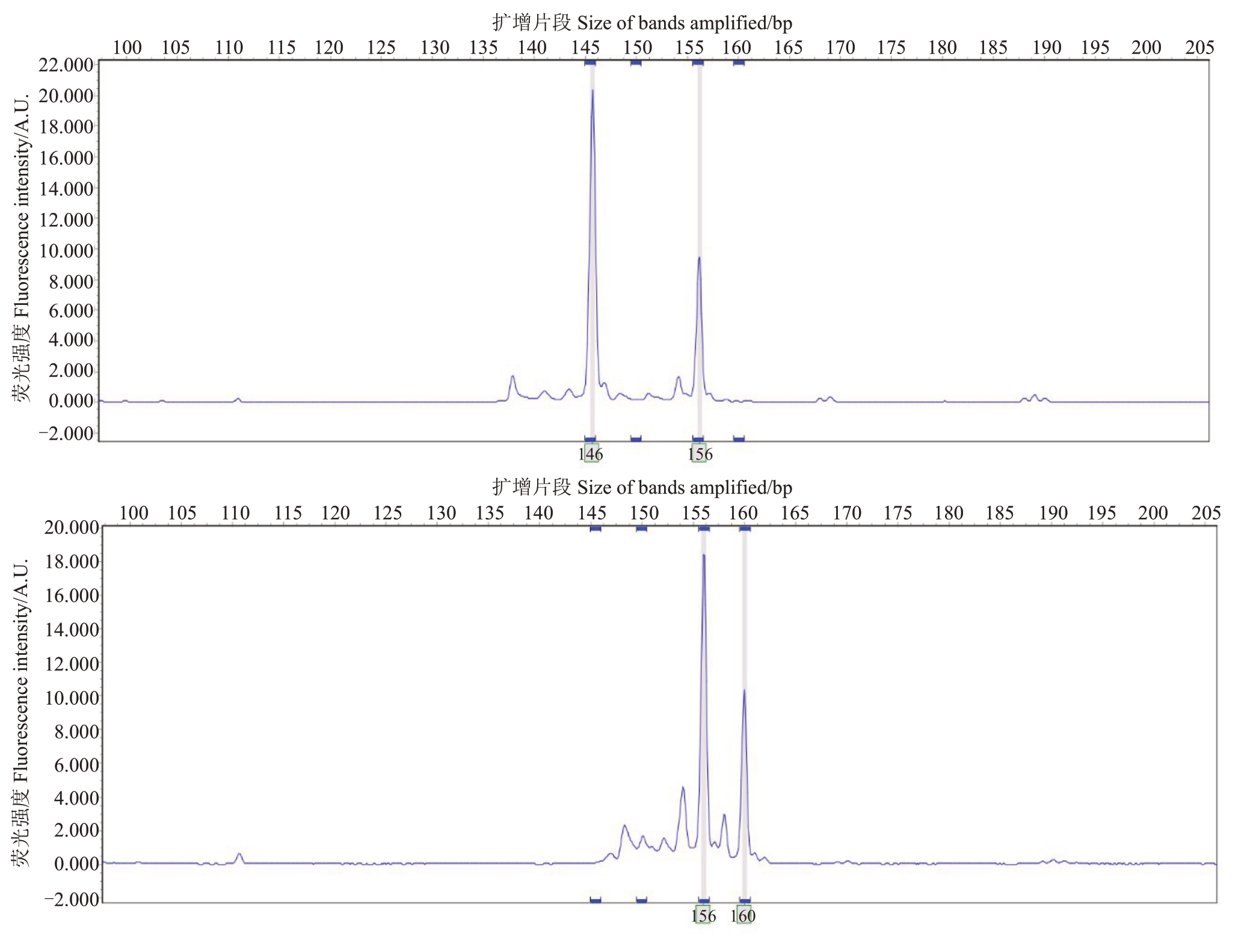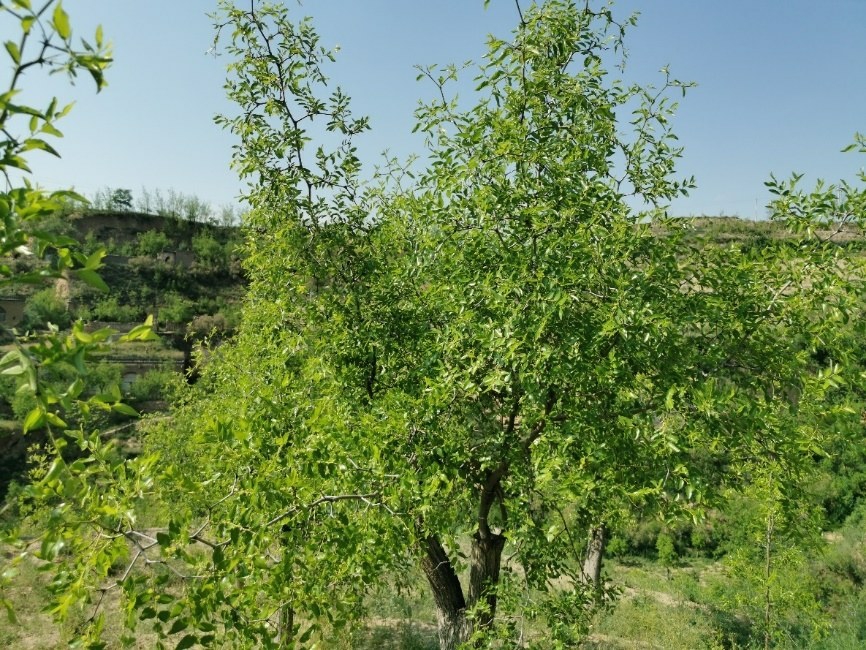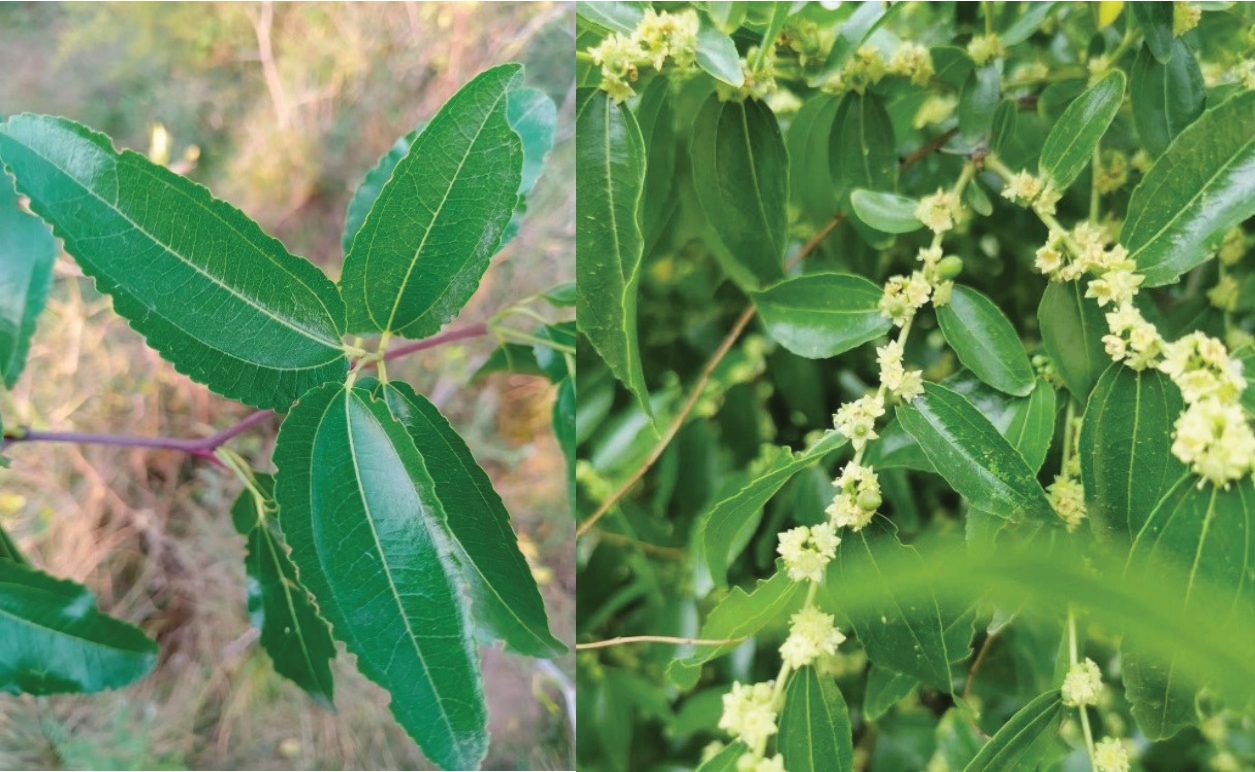酸枣(Ziziphus jujuba var.spinosa)为鼠李科(Rhamanaceae)枣属(Zizyphus)植物[1],原产中国,又称“棘”。《神农本草经》中记载,酸枣可“安五脏,轻身延年”,酸枣仁、叶、花均具有不同的营养或药用价值[2-3]。酸枣富含多种维生素,尤其是抗坏血酸(维生素C)含量明显高于枣[4],在医学上被用来降血压和清洁血液,常用作神经镇静剂、胃补品、止咳药和抗哮喘药,也被用作一般补品[5-6]。随着社会的发展、生活节奏的加快、人们健康意识的增强,医疗、保健、饮食等对酸枣的需求也逐渐增加。过去对酸枣的研究主要集中在酸枣杂交技术[7-8]、遗传多样性[9-10]、无性繁殖技术[11-12]以及酸枣抗性评价[13-14]等方面,而酸枣品种选育工作相对薄弱。
目前已报道的酸枣品种,按照枣果的形态分为球形酸枣、卵圆形酸枣、椭圆形酸枣、扁圆形酸枣等类型[15],根据用途可分为药用酸枣、鲜食酸枣以及兼用酸枣[1]。按照果实口感可以分为甜酸枣,常用于制作果脯、饮料等;酸甜酸枣,果实口感酸甜适中,常用于鲜食;酸酸枣:果味酸涩,常用于烹饪、制作果酱等[16]。山西是中国酸枣主要产区之一,已有2000多年种植历史,被誉为“酸枣之乡”。目前,山西省酸枣种植面积和产量均居全国前列,种植区主要分布在太原、运城、临汾、忻州、吕梁等地[17]。随着人们对酸枣保健和药用功效的深入认识以及市场对酸枣需求量的增加,酸枣供需一度呈紧俏状态。山西省在酸枣的供给方面,因缺少适宜的酸枣栽培品种,以采收野生酸枣为主,其品种杂乱,造成酸枣品次、质量优劣不一;另因酸枣多生长在坡地、山崖、田埂、荒地,枣农在采收酸枣过程中,多以砍、剪等方式获取,影响到当地的生态、景观,也不利于酸枣产业健康和可持续发展。因此,开展适宜的酸枣品种选育对解决当前酸枣供需和稳定酸枣品质等具有重要意义。
1 选育过程
2006年,山西农业大学(山西省农科院)果树研究所,对酸枣主产区的地方品种资源进行了系统调查,在野生酸枣群体中以丰产性强、果个大、果肉口感好、枣仁饱满、抗病、抗裂等为目标进行酸枣优良单株的筛选。2007 年初在临县野生酸枣群体中筛选出37株综合表现良好的单株,嫁接在临县林家坪镇薛家圪台枣园里进行比较试验,经3 a(年)的观察和研究,发现其中3号、8号、9号、21号、35号综合性状较好;随后进行了3 a 的对比研究,决选出综合性状最为优异的3 号单株。3 号单株主要表现为长势旺盛,果个大,肉质厚,口感酸甜,酸枣仁肥大饱满,10月中上旬完熟,裂果率低。即以其作为母株采集接穗,分别在临县林家坪、碛口等地枣园进行高接试验。
2015年以嫁接植株作为采穗母株,扩大嫁接面积。高接酸枣树嫁接当年即可挂果,3 a后可形成产量,5 a 后进入盛果期,丰产性状稳定。2017 年在临县林家坪、碛口大面积嫁接发展的同时,也在临汾永和县、晋中太谷县进行区域栽培试验,均表现良好。综上,经过5 a 的区域栽培试验、该酸枣品种表现良好,性状稳定,无变异现象。2022年9月该品系通过田间鉴定,12月通过山西省林业和草原局林木品种审定委员会审定,定名为晋酸1 号(良种编号:晋SSV-ZJ-017-2022)。
根据中华人民共和国林业行业标准LY/T 2426—2015《枣品种鉴定技术规程SSR 分子标记法》发布的核心引物24对,对晋酸1号和山西临县野生酸枣进行分子鉴定,结果显示,24对引物中,有17对引物可将野生酸枣与晋酸1号区分(表1),通过引物BFU1205测序后的区分结果见图1。

图1 SSR 分子标记在酸枣(上)和晋酸1 号(下)中的扩增结果(引物BFU1205)
Fig.1 Amplification results of wild jujube(up)and Jinsuan No.1(down)by SSR molecular markers BFU1205
表1 酸枣SSR 标记引物及鉴定区分情况
Table 1 SSR marker primers and identification of wild jujube

2 主要性状
2.1 植物学特征
晋酸1号树姿开张,树势中庸。叶片卵状披针形,长2.5~6.8 cm,宽2.0~3.5 cm,叶基偏斜1.1~2.9 mm;叶柄长3~6 mm;枣吊长13~25 cm(图2、图3)。

图2 晋酸1 号长势情况
Fig.2 Growth situation of Jinsuan No.1

图3 晋酸1 号枣叶片和花性状
Fig.3 Leaf and flower traits of Jinsuan No.1
2.2 果实经济性状和营养成分含量
晋酸1号果实近圆形、果顶平,果皮薄,红色,果个大(图4)。平均单果质量4.75 g,最大单果质量5.8 g,平均横径1.9 cm,平均纵径2.2 cm;果肉厚、汁液多、致密细脆、无渣、风味酸甜、可食率84.7%、可溶性固形物含量(w,后同)为27.6%、还原糖(以葡萄糖计)含量为8.5%、总糖含量为27.04%、维生素C含量为419 mg·100 g-1,可滴定酸含量为1.032%;果仁饱满、含仁率100%、平均单仁质量0.1 g。该品种与对照品种(临县野生酸枣)的果实主要经济性状和营养成分含量的对比见表2和表3。

图4 晋酸1 号枣果性状
Fig.4 Fruit characters of Jinsuan No.1
表2 晋酸1 号及对照品种果实主要经济性状
Table 2 Economic characters of fruits of Jinsuan No.1 and control cultivar

表3 晋酸1 号及对照品种鲜果营养成分含量
Table 3 Fresh fruit nutrition of Jinsuan No.1 and control cultivar

2.3 物候期
晋酸1 号在吕梁临县沿黄丘陵山地4 月20 日左右开始萌芽,5 月下旬进入初花期,6 月上旬进入盛花期,9 月中下旬果实进入脆熟期,10 月中上旬果实进入完熟期,10 月下旬落叶期。营养生长170~180 d,果实生育期115 d 左右,属晚熟品种。比当地常见野生酸枣品种晚熟20 d 以上。该品种与对照品种(当地常见野生酸枣)的主要物候期见表4。
表4 晋酸1 号及参照品种的主要物候期
Table 4 Phenological periods of Jinsuan No.1 and control cultivar

2.4 果实抗裂性能
2017—2021年调查了晋酸1号和临县丘陵山地酸枣枣果的抗裂表现。在酸枣枣果成熟期遇到连阴雨天气,晋酸1号由于具有成熟期极晚的特性,避开当地雨季,未出现裂果,经过连续5 a调查,晋酸1号酸枣枣果裂果率均低于1.0%。
2.5 主要用途
晋酸1 号具有果个大、皮薄、肉多、商品性好等特点,可作为鲜食品种或用于制作高档果汁、果酒、果酱的重要原料。其果仁饱满、果实含仁率高,也可作为优异的仁用酸枣品种。除上述用途外也可将晋酸1号制干后作为休闲食品或零食。
2.6 适应性
晋酸1 号适栽于山西1200 m 以下海拔区域及山西省中南部(太原以南)酸枣适生区,该品种表现出早果丰产,综合品质优良,抗逆性、适应性强,性状稳定等特点,也适宜国内同类气候地区栽培。
3 栽培技术要点
3.1 选地建园
晋酸1 号建园时要选择交通便利、通风向阳的山坡、丘陵、平原等地,地块土壤湿度不能过大,黏性不能过重,具备良好的排水条件。
3.2 栽植密度
该品种适宜高密度栽培,建议株行距为1.0 m×2.0 m,每666.7 m2栽植333 株。可依据当地土壤及土地环境条件、树形及栽培模式等决定适宜的密度。
3.3 土肥水条件要求
该品种适应性和抗逆性较强,对土肥水条件要求不严格。秋季落叶后,结合扩穴、施肥,深翻一次土壤,提高土壤肥力,改善土壤通透性。
3.4 树形和整形修剪技术
嫁接幼树期,采取夏季摘心、除蘖、抹芽,促进嫁接新梢生长,延长二次枝长度,为以后连年丰产稳产奠定基础;休眠期进行整形修剪,扩大树冠,培养树形。
盛果期,继续扩大树冠,培养树形,疏除过密枝、交叉重叠枝、机械损伤枝、下垂细弱枝等,及时抹除无用萌芽,创造通风透光的良好条件。
3.5 高接换优技术
选择树体生长旺盛、树龄15 a 以下枣树进行改接。枣树发芽后1个月内嫁接,北方地区一般在5月初开始至6 月初结束,可采用劈接或皮下嫁接法。改接后用愈合剂涂抹伤口促进愈合,对有甲口虫等害虫侵染的果园,需涂抹杀虫剂预防害虫危害愈伤组织;及时除蘖、抹芽,新梢长至30 cm左右时,绑缚支架,预防风折。
3.6 花果管理技术
采用摘心、拉枝、花期喷布1次赤霉素等措施促进坐果。
[1] 刘孟军,王永蕙.酸枣的优良品种和类型[J].中国果树,1991(4):23-25.LIU Mengjun,WANG Yonghui.Fine varieties and types of wild jujube[J].China Fruits,1991(4):23-25.
[2] 杨冲,李宪松,刘孟军.酸枣的营养成分及开发利用研究进展[J].北方园艺,2017(5):184-188.YANG Chong,LI Xiansong,LIU Mengjun.Research progress on chemical constituents and utilization of sour jujube (Ziziphus acidojujuba Cheng et Liu)[J].Northern Horticulture,2017(5):184-188.
[3] 董忠义,黄本敏.酸枣的药用功效[J].中国林业,1996(10):40.DONG Zhongyi,HUANG Benmin.Medicinal properties of wild jujube[J].Forestry of China,1996(10):40.
[4] 毕景歆,吴梦嘉,张跃武,张春梅.枣和酸枣AsA 积累特点及关键功能基因鉴定[J].果树学报,2023,40(9):1823-1831.BI Jingxin,WU Mengjia,ZHANG Yuewu,ZHANG Chunmei.Analysis of ascorbic acid in jujube/sour jujube and identification of key function genes[J].Journal of Fruit Science,2023,40(9):1823-1831.
[5] LIU S J,LV Y P,TANG Z S,ZHANG Y,XU H B,ZHANG D B,CUI C L,LIU H B,SUN H H,SONG Z X,WEI S M.Ziziphus jujuba Mill.,a plant used as medicinal food:A review of its phytochemistry,pharmacology,quality control and future research[J].Phytochemistry Reviews,2021,20(3):507-541.
[6] PRAKASH O,USMANI S,SINGH R,SINGH N,GUPTA A,VED A.A panoramic view on phytochemical,nutritional,and therapeutic attributes of Ziziphus mauritiana Lam.:A comprehensive review[J].Phytotherapy Research,2021,35(1):63-77.
[7] 闫芬芬,郑兴娟,罗智,王玖瑞,刘孟军.枣和酸枣杂交后代遗传多样性的SSR 分析[J].西北林学院学报,2018,33(3):91-97.YAN Fenfen,ZHENG Xingjuan,LUO Zhi,WANG Jiurui,LIU Mengjun.Genetic diversity analysis of hybrid progeny from Chinese jujube and wild jujube by SSR[J].Journal of Northwest Forestry University,2018,33(3):91-97.
[8] 刘平,薛慧智,邹向阳,刘孟军,毛永民,周俊义.枣、酸枣授粉生物学基础研究[J].果树学报,2004,21(3):224-228.LIU Ping,XUE Huizhi,ZOU Xiangyang,LIU Mengjun,MAO Yongmin,ZHOU Junyi.Study on the biological basis of pollination in Chinese jujube(Zizyphus jujuba)and wild jujube(Z.spinosa)[J].Journal of Fruit Science,2004,21(3):224-228.
[9] 李世鹏,陈叶,郭明欣,田珊,刘红霞,赵旭升.86 份酸枣种质资源筛选和遗传多样性分析[J].安徽农业科学,2019,47(11):51-55.LI Shipeng,CHEN Ye,GUO Mingxin,TIAN Shan,LIU Hongxia,ZHAO Xusheng.Screening and genetic diversity analysis of 86 sour jujube germplasm resources[J].Journal of Anhui Agricultural Sciences,2019,47(11):51-55.
[10] 张春梅,殷晓,李新岗,黄建,王长柱,练春兰.黄河沿岸酸枣遗传多样性研究[J].西北农林科技大学学报(自然科学版),2013,41(12):107-112.ZHANG Chunmei,YIN Xiao,LI Xingang,HUANG Jian,WANG Changzhu,LIAN Chunlan.Genetic diversity of sour jujube along the Yellow River[J].Journal of Northwest A&F University(Natural Science Edition),2013,41(12):107-112.
[11] 崔向东.野生酸枣的无性快繁技术[J].林业实用技术,2011(6):27-28.CUI Xiangdong.Asexual rapid propagation technology of wild jujube[J].Practical Forestry Technology,2011(6):27-28.
[12] 崔向东.野生酸枣嫩枝扦插技术研究[J].安徽农业科学,2009,37(28):3563-3565.CUI Xiangdong.Research on the technique of wild jujube softwood cutting[J].Journal of Anhui Agricultural Sciences,2009,37(28):3563-3565.
[13] 刘青柏,陆洁,刘权钢,董胜君.土壤水分胁迫对不同酸枣无性系抗旱性的影响[J].北方园艺,2023(4):16-24.LIU Qingbai,LU Jie,LIU Quangang,DONG Shengjun.Effects on drought resistance of different Zizyphus acidojujuba clones under water stress[J].Northern Horticulture,2023(4):16-24.
[14] 郑强卿,李鹏程,陈奇凌,王晶晶.干旱胁迫下不同产地酸枣抗性生理指标综合评价[J].新疆农业科学,2017,54(4):618-625.ZHENG Qiangqing,LI Pengcheng,CHEN Qiling,WANG Jingjing.Comprehensive evaluation of the wild jujube resistance physiological indexes in different producing areas under the condition of drought stress[J].Xinjiang Agricultural Sciences,2017,54(4):618-625.
[15] 曲泽洲,王永蕙.中国果树志·枣卷[M].北京:中国林业出版社,1993:461-475.QU Zezhou,WANG Yonghui.Chronicles of Chinese fruit trees · Jujube Volume[M].Beijing:China Forestry Publishing House,1993:461-475.
[16] 张建英,毛向红,黄岩.酸枣种质资源综合性状评价[J].河北林业科技,2010(6):10-13.ZHANG Jianying,MAO Xianghong,HUANG Yan.Evaluation on comprehensive characters of Ziziphus jujuba germplasm resources[J].The Journal of Hebei Forestry Science and Technology,2010(6):10-13.
[17] 裴香萍,李晓兰,丁雯,闫艳,尚彩玲,王玉龙,杜晨晖.山西酸枣种质资源调查分析报告[J].中国民族民间医药,2022,31(2):49-54.PEI Xiangping,LI Xiaolan,DING Wen,YAN Yan,SHANG Cailing,WANG Yulong,DU Chenhui.Lnvestigation and analysis on the germplasm resources of Ziziphus jujube Mill.var.spinosa in Shanxi Province[J].Chinese Journal of Ethnomedicine and Ethnopharmacy,2022,31(2):49-54.